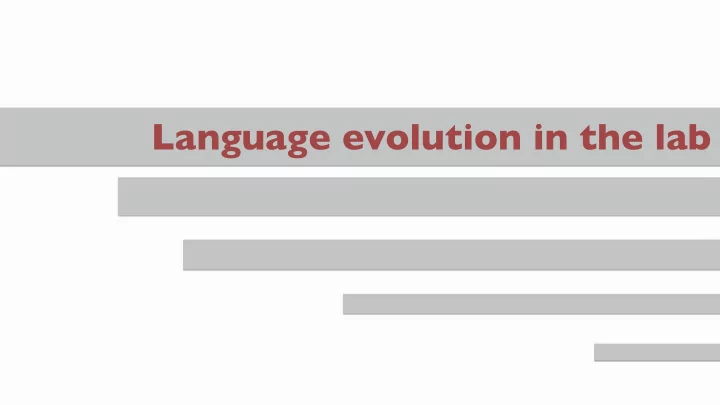

Language evolution in the lab
language evolution synthesized agent-based simulations iterated learning experimental semiotics evolutionary game theory 2
evolving an artificial code
Bruno Galantucci (2005) An Experimental Study on the Emergence of Human Communication Systems. Cognitive Science 29 737—767 4
Setup 5
Setup 6
Setup 7
Setup 8
procedure ‣ participants: 10 pairs of participants; paid 8$/h ‣ successful trial: get both participants into the same room with maximally one room change of each player ‣ scoring: players start with a score of 50; each minute 1 point is deduced (no matter what); each failure deduces 4 points; each success gains 2 points; ‣ goal: reach 100 points ‣ communication: free to use any time ‣ final test: assess the communication system (if any) player had evolved 9
Results 10
Results 11
iterated learning in the lab
Simon Kirby , Hannah Cornish and Kenny Smith (2008) Cumulative cultural evolution in the laboratory: An experimental approach to the origins of structure in human language . PNAS 105 (31) 10681—10686 iterated learning 13
Setup Experiment 1 ‣ participants: 40 participants arranged into 4 chains of 10 learners ‣ procedure: each participant gets random half of the language to be learned; then produces a string for each meaning (including for novel meanings not encountered during training) ๏ initial participant tries to learn initial random language ๏ every next participant tries to learn output from the previous 14
measures of interest ‣ error: rescaled average Levenshtein between produced word and correct word (including for meanings not in the training set) ‣ structure: correlation between edit- distances of words and edit-distance of corresponding meanings ๏ edit-distances of meanings by form, movement and color 15
results Experiment 1 16
results Experiment 1 17
Setup Experiment 2 ‣ participants: 40 participants arranged into 4 chains of 10 learners ‣ procedure: each participant gets random half of the language to be learned after filtering for ambiguous word-meaning pairs ; then produces a string for each meaning (including for novel meanings not encountered during training) ๏ initial participant tries to learn initial random language ๏ every next participant tries to learn output from the previous 18
results Experiment 2 19
results Experiment 2
signaling signalhood
Thomas Scott-PhilippsSimon Kirby , Hannah Cornish and Kenny Smith (2009) Signalling signalhood and the emergence of communication . Cognition 113 226—233 22
signaling theory signaling game evolutionary stable states Lewis information content vector skyrms strategies ICV ( m ) = ⟨ log P S ( t 1 ∣ m ) sender: receiver: P R ( a ∣ m ) P S ( m ∣ t ) ⟩ , log P S ( t 2 ∣ m ) P ( t 1 ) P ( t 2 ) 23
signaling theory signaling game evolutionary stable states Lewis signaling signalhoood problem previous models /studies focus on mapping of given meanings to given signals with reasonable clarity about (i) that communication needs to occur and (ii) what the communication channel is information content vector skyrms strategies ICV ( m ) = ⟨ log P S ( t 1 ∣ m ) sender: receiver: P R ( a ∣ m ) P S ( m ∣ t ) ⟩ , log P S ( t 2 ∣ m ) P ( t 1 ) P ( t 2 ) 24
design 25
Setup Experiment 1 ‣ participants: 12 pairs of participants ‣ procedure: each pairs plays for 40 minutes uninterrupted (after a 3 min training phase); each agent moves around until they decide on a quadrant; ‣ trials: colors assigned to quadrants where random except that players must have at least one color in common ‣ points: longest streak of subsequent successes 26
results Experiment 1 27
results Experiment 1 28
results Experiment 1 29
Setup Experiment 2 ‣ participants: 12 pairs of participants ‣ procedure: each pairs plays for 40 minutes uninterrupted (after a 3 min training phase); each agent moves around until they decide on a quadrant; ‣ trials: colors assigned to quadrants where random except that players must have at least one color in common and that the previous “winning color” was never present in the subsequent trial ‣ points: longest streak of subsequent successes 30
results Experiment 1 31
Recommend
More recommend